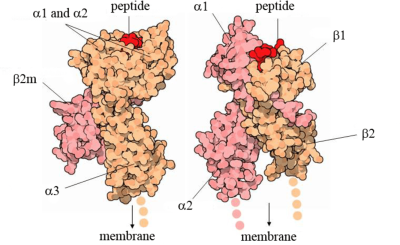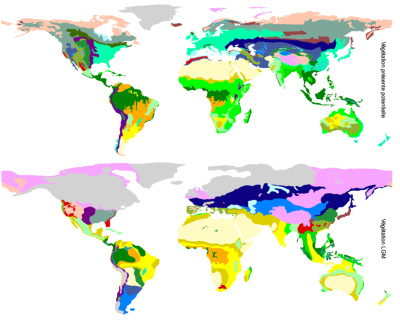This project aims at investigating the role of both human peopling history and environmental factors on the molecular diversity and evolution of the major histocompatibility complex (MHC) in humans - the HLA system.
Project scope
- Do the patterns of HLA diversity differ significantly among populations living in contrasting environments?
- Are the allelic repertoires observed in populations living in contrasting environments functionally relevant to explain HLA diversity?
- Does natural selection acting on HLA vary significantly in type and intensity in contrasting environments?
- Are the patterns of HLA diversity partly explained by adaptive introgression of functionally relevant HLA alleles from archaic humans?
These and other questions related to human settlement history are addressed through the molecular and bio-statistical analysis of several genes involved in our immunity: the HLA genes.

The HLA molecule plays a crucial role in the adaptive immune response against pathogens in all world environments
To achieve this project, we are generating a large amount of new HLA genetic data by using next generation sequencing (NGS) technology in about 5,000 individuals from 50 human populations living in different continents and environments.

Global environments changed drastically since the Mesolithic period. Top: present-day vegetation map; bottom: Last Glacial Maximum (LGM) vegetation map, about 20’000 years ago (Courtesy of Nicolas Ray 2003)
We are also developing new resampling proceduresfor the estimation of haplotype frequencies, linkage disequilibrium and other statistics useful to analyze complex multi-locus HLA data, and new simulation algorithms including variable types and intensities of natural selection (i.e. positive, balancing) to simulate specific scenarios of human population expansions. We are also exploring the functional variability of HLA molecules by analyzing the allelic repertoires of populations adapted to distinct environments in relation to MHC peptide-binding motifs and environmental variables.

A large set of population samples typed for HLA loci are being used in this study (red dots: new samples typed by NGS technology).
Project innovations
A large dataset of new population samples…
…representing more than 50 populations (about 5,000 individuals), many of them living in pathogen-rich environments (e.g. malaria endemic areas in Africa).
NGS data for multiple HLA genes…
…representing huge sets of unambiguous HLA molecular data allowing a much finer detection of polymorphism than former technologies.
Original methods in population and evolutionary genetics…
…including new implementations in Gene[rate], now integrated into the HLA-net platform and allowing users to compare directly their own data to the Gene[VA] database;
…including new implementations in Selector allowing to account for diverse kinds and intensities of selection.
An inter-disciplinary approach…
…using functional, epidemiologic and environmental data to understand better HLA molecular variation throughout the world.
Partenaires
- Maxime Galan (Centre de Biologie pour la Gestion des Populations, Montpellier)
- Jean-Marie Tiercy (HUG, Geneva)
- Viktor Cerny (Laboratory of Archaeogenetics, Prague)
- Jacques Chiaroni (EFS Marseilles)
- Julie Di Cristofaro (EFS Marseilles)
- Jean-Michel Dugoujon (University Paul Sabatier, Toulouse)
- Qasim Mehdi (Sindh Institute of Urology and Transplantation, Karachi)
- Hacène Brouk (University of Badji Mokthar, Annaba)
- Gottfried Fischer (University of Vienna)
- Farha El-Chennawi (Faculty of Medicine, Mansoura)
- Ludmila Osipova (Institute of Cytology and Genetics, Novosibirsk)
- Nicolas Ray (Institut des Sciences de l’Environnement, University of Geneva)
Sélection de publications en relation avec le projet
- Nunes JM, Buhler S, Roessli D, Sanchez-Mazas A & the HLA-net 2013 collaboration. (2014) Review Article: The HLA-net Gene[rate] pipeline for effective HLA data analysis and its application to 145 population samples from Europe and neighbouring areas. Tissue Antigens 83:307-323.
- Prifti-Kurti M, Nunes JM, Shyti E, Ylli Z, Sanchez-Mazas A, Sulcebe G. (2014) HLA-DRB1 and HLA-DQB1 allele associations in an Albanian patient population with rheumatoid arthritis: correlations with the specific autoantibody markers and inter-population DRB1 allele frequency variability. Rheumatology International, DOI 10.1007/s00296-013-2932-8.
- Sanchez-Mazas A & Barbujani G, eds. (2013, published in 2014) Genetic Diversity in European Populations: Evolutionary Evidence and Medical Implications. Human Heredity, Special volume, Vol. 76, No.3-4.
- Sanchez-Mazas A & Barbujani G. (2013, published in 2014) European genetic diversity through space and time. Human Heredity 76:119-120.
- Sanchez-Mazas A, Buhler S, Nunes JM. (2013, published in 2014) A new HLA map of Europe: regional genetic variation and its implication for peopling history, disease-association studies and tissue transplantation. Human Heredity 76:162-177.
- Sanchez-Mazas A, Meyer D. (2014) The Relevance of HLA Sequencing in Population Genetics Studies. Journal of Immunology Research, vol. 2014, Article ID 971818, 12 pages, 2014.
- Di D and Sanchez-Mazas A. (2014) HLA variation reveals genetic continuity rather than population group structure in East Asia. Immunogenetics 66:153-160.
- Riccio ME, Buhler S, Nunes JM, Vangenot C, Cuénod M, Currat M, Di D, Andreani M, Boldyreva M, Chambers G, Chernova M, Chiaroni J, Darke C, Di Cristofaro J, Dubois V, Dunn P, Edinur HA, Elamin N, Eliaou JF, Grubic Z, Jaatinen T, Kanga U, Kervaire B, Kolesar L, Kunachiwa W, Lokki ML, Mehra N, Nicoloso G, Paakkanen R, Voniatis DP, Papasteriades C, Poli F, Richard L, Romón Alonso I, Slavčev A, Sulcebe G, Suslova T, Testi M, Tiercy JM, Varnavidou A, Vidan-Jeras B, Wennerström A, Sanchez-Mazas A. (2013) 16(th) IHIW: analysis of HLA population data, with updated results for 1996 to 2012 workshop data (AHPD project report). International Journal of Immunogenetics. 2013 Feb;40(1):21-30. doi: 10.1111/iji.12033. Epub 2012 Dec 22, archive-ouverte.unige.ch/unige:25791
- Sanchez-Mazas, A.; Lemaître, J.-F.; Currat M. (2012) Distinct evolutionary strategies of human leucocyte antigen loci in pathogen-rich environments. Philosophical Transactions of the Royal Society B, Biological Sciences 367 (1590) 830-839 archive-ouverte.unige.ch/unige:18732
- Sanchez-Mazas A, Vidan-Jeras B, Nunes JM, Fischer G,Little AM, Bekmane U, Buhler S, Buus S, Claas FH, Dormoy A, Dubois V, Eglite E, Eliaou JF, Gonzalez-Galarza F, Grubic Z, Ivanova M, Lie B, Ligeiro D, Lokki ML, Martins da Silva B, Martorell J, Mendonça D, Middleton D, Voniatis DP, Papasteriades C, Poli F, Riccio ME, Vlachou MS, Sulcebe G, Tonks S, Nevessignsky MT, Vangenot C, van Walraven AM, Tiercy JM (2012) Strategies to work with HLA data in human populations for histocompatibility, clinical transplantation, epidemiology and population genetics: HLA-NET methodological recommendations. International Journal of Immunogenetics. Article first published online: 25 APR 2012 | DOI: 10.1111/j.1744-313X.2012.01113.x.
